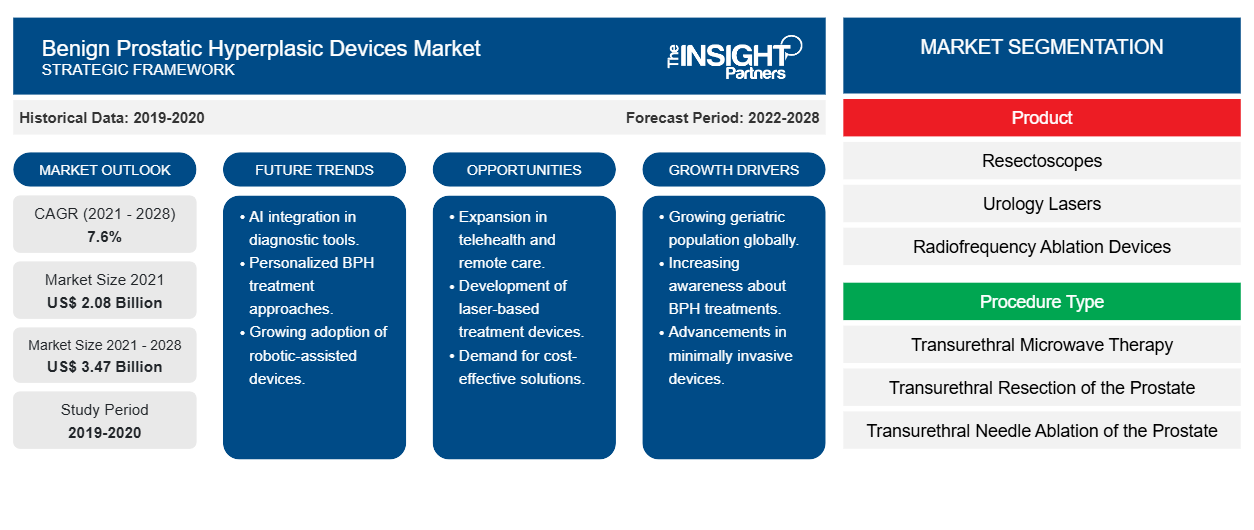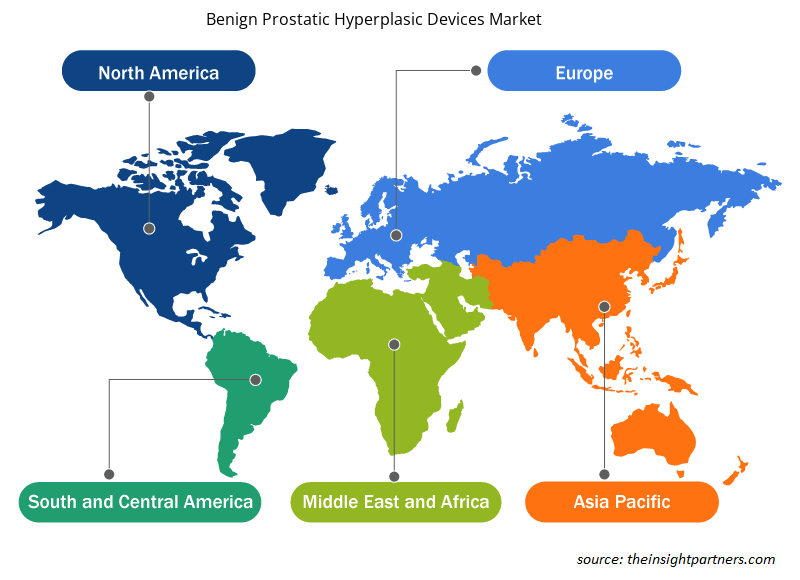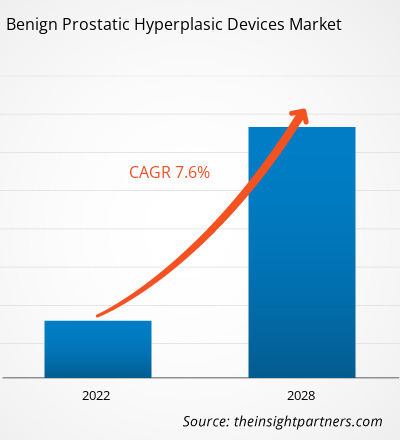[Research Report] The benign prostatic hyperplasic devices market is expected to grow from US$ 2,078.78 million in 2021 to US$ 3,467.31 million by 2028; it is estimated to grow at a CAGR of 7.6% from 2022 to 2028.
Benign prostatic hyperplasia (BPH) is a prostate enlargement caused by excessive cell growth in the prostate. BPH is a benign (non-cancerous) prostate condition. Non-cancerous conditions are not usually fatal and do not spread (metastasize) to other body parts. BPH doesn't raise the risk of prostate cancer; unless it manifests symptoms, BPH isn't considered a health issue. Almost all men will have some prostate growth by the age of 70. Getting older, having more belly fat (also known as abdominal obesity), and not getting enough exercise to raise the risk of developing BPH.
The benign prostatic hyperplasic devices market is segmented into product, procedure type, end user, and geography. By geography, the market is broadly segmented into North America, Europe, Asia Pacific, the Middle East & Africa, and South & Central America. This report offers insights and in-depth analysis of the market, emphasizing parameters, such as market trends, market dynamics, and the competitive analysis of the globally leading market players.
Customize This Report To Suit Your Requirement
You will get customization on any report - free of charge - including parts of this report, or country-level analysis, Excel Data pack, as well as avail great offers and discounts for start-ups & universities
Benign Prostatic Hyperplasic Devices Market: Strategic Insights

- Get Top Key Market Trends of this report.This FREE sample will include data analysis, ranging from market trends to estimates and forecasts.
You will get customization on any report - free of charge - including parts of this report, or country-level analysis, Excel Data pack, as well as avail great offers and discounts for start-ups & universities
Benign Prostatic Hyperplasic Devices Market: Strategic Insights

- Get Top Key Market Trends of this report.This FREE sample will include data analysis, ranging from market trends to estimates and forecasts.
Market Insights
Increase in prevalence of benign prostatic hyperplasia along with growing risk factors, and a rise in investments, funds, and grants for research in BPH treatment to drive benign prostatic hyperplasic devices market.
According to the National Center for Biotechnology Information (NCBI), BPH is one of the most common disorders in older men and the leading cause of lower urinary tract symptoms (LUTS). After the age of 40, the prevalence of BPH rises, reaching a peak of 60% by the age of 90. According to autopsy studies, the histological prevalence of BPH is 8%, 50%, and 80% in the fourth, sixth, and ninth decades of a man's life, respectively. Old age has also been shown to be a risk factor for the onset and progression of clinical BPH in observational studies conducted in Europe, the US, and Asia. According to statistics from the Krimpen and Baltimore Longitudinal Study of Aging, the prostate grows at a rate of 2.0% to 2.5% per year in older men. Continued prostate enlargement is a risk factor for developing LUTS, and larger prostates are associated with a benign prostatic enlargement (BPE), which triggers the risk of developing clinical BPH and urine incontinence.
According to NCBI data, increased adiposity is found to have a positive correlation with prostate volume. In numerous study groups, body weight, body mass index (BMI), and waist circumference have been seen to have a positive correlation with prostate volume. Additionally, epidemiological data shows obesity may raise the necessity of BPH surgery and initiating BPH treatment.
According to the American Journal of Men's Health (AJMH), in 2019, globally, there were 11.26 million new cases and 1.86 million Years Lived with Disability (YLD) due to BPH in 2019. The incidence of BPH increased by 105.7%, and YLD increased by 110.6% worldwide during 1990–2019. The absolute incidence and YLD numbers increased considerably worldwide during this period, primarily due to population increase and aging. As per the estimates by UROLOGY FOUNDATION, in the UK, the prevalence of BPH rises from 50% among men aged 50–60 to 90% among men aged 80 and above. Some men develop sudden acute retention, i.e., the inability to pass urine. The treatment option for BPH includes surgeries such as transurethral resection of the prostate (TURP), open prostatectomy, and minimally invasive treatments such as transurethral needle ablation (TUNA). In minimally invasive treatments such as radiofrequency ablation, laser therapy, and implants, benign prostatic hyperplasic devices are used. Thus, the increase in the prevalence of benign prostatic hyperplasia and increasing risk factors are bolstering the demand for benign prostatic hyperplasic devices.
Product Insights
Based on the product, the benign prostatic hyperplasic devices market is segmented into resectoscopes, radiofrequency ablation devices, urology lasers, prostatic stents, and implants. The resectoscopes segment is likely to hold the largest market share in 2022. However, the urology lasers segment is anticipated to register the highest CAGR during the forecast period due to the high demand by physicians and the rising initiatives of market players in the launch and product expansion.
Procedure Type Insights
Based on procedure type, the benign prostatic hyperplasic devices market is segmented into transurethral microwave therapy, transurethral resection of the prostate, transurethral needle ablation of the prostate, laser surgery, urolift surgery, and others. In 2022, the transurethral resection of the prostate segment is likely to hold the market's largest share. Furthermore, the same segment is expected to witness growth in its demand at the fastest CAGR from 2022 to 2028, owing to its visual, hands-on access to the prostate, ability to immediate removal of excess tissue, the ability of transurethral resection of the prostate (TURP) to combine with other procedures.
End User Insights
Based on end user, the benign prostatic hyperplasic devices market is segmented into hospitals, clinics, ambulatory surgical centers, and others. In 2022, the hospitals segment is likely to hold the largest share of the market. Moreover, the clinics segment is expected to witness growth in its demand at the fastest CAGR from 2022 to 2028, owing to an increase in the number of clinics at a lower cost for treatment, easy accessibility, and flexibility with the short waiting time.
Organic developments such as product launches and approvals are highly adopted strategies by the global benign prostatic hyperplasic devices market players. A few of the recent key market developments are listed below:
- In April 2022, Teleflex Incorporated launched the UroLift System in Japan for treating BPH or enlarged prostate. The system was made available for purchase immediately after the launch.
- In April 2020, Olympus announced the approval of iTind, its nonsurgical medical device, for the minimally invasive surgery of BPH. This is a temporarily urethral opening device that has been given a De Novo classification by the FDA and is a Class II medical device.
Benign Prostatic Hyperplasic Devices Market - Segmentation
The global benign prostatic hyperplasic devices market is segmented into product, procedure type, end user, and geography. Based on product, the market is segmented into resectoscopes, radiofrequency ablation devices, urology lasers, prostatic stents, and implants. Based on the procedure type, the market is segmented into transurethral microwave therapy, transurethral resection of the prostate, transurethral needle ablation of the prostate, laser surgery, urolift surgery, and others. Based on end user, the market is differentiated into hospitals, clinics, ambulatory surgical centers, and others. By geography, the market is segmented into North America, Europe, Asia Pacific, the Middle East & Africa, and South & Central America.
Benign Prostatic Hyperplasia Devices Benign Prostatic Hyperplasic Devices Market Regional Insights
The regional trends and factors influencing the Benign Prostatic Hyperplasic Devices Market throughout the forecast period have been thoroughly explained by the analysts at Insight Partners. This section also discusses Benign Prostatic Hyperplasic Devices Market segments and geography across North America, Europe, Asia Pacific, Middle East and Africa, and South and Central America.

- Get the Regional Specific Data for Benign Prostatic Hyperplasic Devices Market
Benign Prostatic Hyperplasic Devices Market Report Scope
| Report Attribute | Details |
|---|---|
| Market size in 2021 | US$ 2.08 Billion |
| Market Size by 2028 | US$ 3.47 Billion |
| Global CAGR (2021 - 2028) | 7.6% |
| Historical Data | 2019-2020 |
| Forecast period | 2022-2028 |
| Segments Covered |
By Product
|
| Regions and Countries Covered | North America
|
| Market leaders and key company profiles |
Benign Prostatic Hyperplasic Devices Market Players Density: Understanding Its Impact on Business Dynamics
The Benign Prostatic Hyperplasic Devices Market is growing rapidly, driven by increasing end-user demand due to factors such as evolving consumer preferences, technological advancements, and greater awareness of the product's benefits. As demand rises, businesses are expanding their offerings, innovating to meet consumer needs, and capitalizing on emerging trends, which further fuels market growth.
Market players density refers to the distribution of firms or companies operating within a particular market or industry. It indicates how many competitors (market players) are present in a given market space relative to its size or total market value.
Major Companies operating in the Benign Prostatic Hyperplasic Devices Market are:
- KARL STORZ SE & Co. KG
- Richard Wolf GmbH
- Olympus Corporation
- Urologix, LLC.
- Boston Scientific Corporation
Disclaimer: The companies listed above are not ranked in any particular order.

- Get the Benign Prostatic Hyperplasic Devices Market top key players overview
Benign Prostatic Hyperplasic Devices Market - Company Profiles
- KARL STORZ SE & Co. KG
- Richard Wolf GmbH
- Olympus Corporation
- Urologix, LLC.
- Boston Scientific Corporation
- Butterfly
- TELEFLEX Incorporated
- OmniGuide Holdings, Inc.
- Convergent Laser Technologies
- ProArc
- Olympus Corporation
Frequently Asked Questions
What is the Benign Prostatic Hyperplasic Devices market?
Benign prostatic hyperplasia (BPH) is a prostate enlargement caused by excessive cell growth in the prostate. BPH is a benign (non-cancerous) prostate condition. Non-cancerous conditions are not usually fatal and do not spread (metastasize) to other body parts. BPH doesn't raise the risk of prostate cancer; unless it manifests symptoms, BPH isn't considered a health issue. Almost all men will have some prostate growth by the age of 70. Getting older, having more belly fat (also known as abdominal obesity), and not getting enough exercise to raise the risk of developing BPH.
What are the driving factors for the benign prostatic hyperplasic devices market across the country?
The factors that are driving and restraining factors that will affect the benign prostatic hyperplasic devices market in the coming years. Factors such as the rise in the prevalence of benign prostatic hyperplasia amongst men, along with increasing risk factors and rise in investments, funds, and grants for research in BPH treatment. However, less awareness about prostate health among men will hamper the market growth.
Which segment is dominating the benign prostatic hyperplasic devices market?
The global benign prostatic hyperplasic devices market based on product is resectoscopes, radiofrequency ablation devices, urology laser, prostatic stents, and implants. The resectoscopes segment is likely to hold the largest share of the market in 2022. However, the urology lasers segment is anticipated to register the highest CAGR of 8.4% in the market during the forecast period.
Who are the major players in the benign prostatic hyperplasic devices market?
The benign prostatic hyperplasic devices market majorly consists of the players such as KARL STORZ SE & Co. KG; Richard Wolf GmbH; Olympus Corporation; Urologix, LLC.; Boston Scientific Corporation; Butterfly; TELEFLEX Incorporated; OmniGuide Holdings, Inc.; Convergent Laser Technologies; ProArc; and Olympus Corporation.
- Historical Analysis (2 Years), Base Year, Forecast (7 Years) with CAGR
- PEST and SWOT Analysis
- Market Size Value / Volume - Global, Regional, Country
- Industry and Competitive Landscape
- Excel Dataset
Testimonials
I wish to appreciate your support and the professionalism you displayed in the course of attending to my request for information regarding to infectious disease IVD market in Nigeria. I appreciate your patience, your guidance, and the fact that you were willing to offer a discount, which eventually made it possible for us to close a deal. I look forward to engaging The Insight Partners in the future, all thanks to the impression you have created in me as a result of this first encounter.
DR CHIJIOKE ONYIA, MANAGING DIRECTOR, PineCrest Healthcare Ltd.The Insight Partners delivered insightful, well-structured market research with strong domain expertise. Their team was professional and responsive throughout. The user-friendly website made accessing industry reports seamless. We highly recommend them for reliable, high-quality research services
Yukihiko Adachi CEO, Deep Blue, LLC.Reason to Buy
- Informed Decision-Making
- Understanding Market Dynamics
- Competitive Analysis
- Customer Insights
- Market Forecasts
- Risk Mitigation
- Strategic Planning
- Investment Justification
- Identifying Emerging Markets
- Enhancing Marketing Strategies
- Boosting Operational Efficiency
- Tracking Industry Innovations
- Aligning with Regulatory Trends
Yes! We provide a free sample of the report, which includes Report Scope (Table of Contents), report structure, and selected insights to help you assess the value of the full report. Please click on the "Download Sample" button or contact us to receive your copy.
Absolutely — analyst assistance is part of the package. You can connect with our analyst post-purchase to clarify report insights, methodology or discuss how the findings apply to your business needs.
Once your order is successfully placed, you will receive a confirmation email along with your invoice.
• For published reports: You’ll receive access to the report within 4–6 working hours via a secured email sent to your email.
• For upcoming reports: Your order will be recorded as a pre-booking. Our team will share the estimated release date and keep you informed of any updates. As soon as the report is published, it will be delivered to your registered email.
We offer customization options to align the report with your specific objectives. Whether you need deeper insights into a particular region, industry segment, competitor analysis, or data cut, our research team can tailor the report accordingly. Please share your requirements with us, and we’ll be happy to provide a customized proposal or scope.
The report is available in either PDF format or as an Excel dataset, depending on the license you choose.
The PDF version provides the full analysis and visuals in a ready-to-read format. The Excel dataset includes all underlying data tables for easy manipulation and further analysis.
Please review the license options at checkout or contact us to confirm which formats are included with your purchase.
Our payment process is fully secure and PCI-DSS compliant.
We use trusted and encrypted payment gateways to ensure that all transactions are protected with industry-standard SSL encryption. Your payment details are never stored on our servers and are handled securely by certified third-party processors.
You can make your purchase with confidence, knowing your personal and financial information is safe with us.
Yes, we do offer special pricing for bulk purchases.
If you're interested in purchasing multiple reports, we’re happy to provide a customized bundle offer or volume-based discount tailored to your needs. Please contact our sales team with the list of reports you’re considering, and we’ll share a personalized quote.
Yes, absolutely.
Our team is available to help you make an informed decision. Whether you have questions about the report’s scope, methodology, customization options, or which license suits you best, we’re here to assist. Please reach out to us at sales@theinsightpartners.com, and one of our representatives will get in touch promptly.
Yes, a billing invoice will be automatically generated and sent to your registered email upon successful completion of your purchase.
If you need the invoice in a specific format or require additional details (such as company name, GST, or VAT information), feel free to contact us, and we’ll be happy to assist.
Yes, certainly.
If you encounter any difficulties accessing or receiving your report, our support team is ready to assist you. Simply reach out to us via email or live chat with your order information, and we’ll ensure the issue is resolved quickly so you can access your report without interruption.















The List of Companies - Benign Prostatic Hyperplasic Devices Market
- KARL STORZ SE & Co. KG
- Richard Wolf GmbH
- Olympus Corporation
- Urologix, LLC.
- Boston Scientific Corporation
- Butterfly
- TELEFLEX Incorporated
- OmniGuide Holdings, Inc.
- Convergent Laser Technologies
- ProArc
- Olympus Corporation






 Get Free Sample For
Get Free Sample For